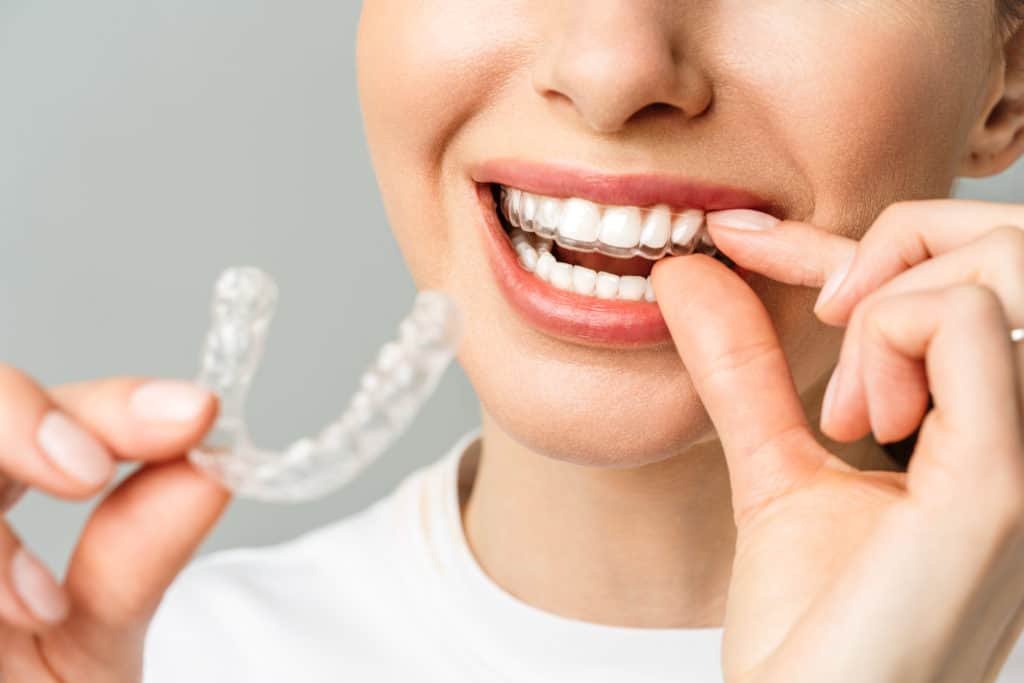If your teeth are crooked or misaligned, you will likely be put forward for orthodontic treatment. Traditional braces would be the best bet until now. Multiple orthodontic options may be a better fit for you. Invisible braces are one of those options.
It may well be the first time you’ve heard of invisible braces, and you’re likely to want to know more, such how do Invisalign work, what is the cost of Invisalign, particularly if you’re considering an alternative to traditional metal braces, so let’s give you the lowdown about invisible braces and whether invisible braces work.
What Are Invisible Braces?
The term invisible braces have become an umbrella term for multiple orthodontic options. Invisible means something that you can’t see. In this case, invisible braces are braces that come with a minimal appearance. They are designed to be less visible to the public compared to traditional braces.
When you hear about invisible braces, you’re hearing about Invisalign braces, ceramic braces or lingual braces. Let’s break down what each of them is.
Invisalign
Invisalign clear aligners are constructed of BPA-thermoplastic and are used to straighten teeth and correct minor misalignment. The dentist develops a mould of your smile and designs the aligners for you to wear as part of the treatment. As part of treatment, you’ll be required to wear the aligners for at least 22 hours per day, but they are removable for the remaining 2 hours of the day when it comes to eating and cleaning your teeth.
Lingual Braces
Lingual braces, sometimes known as “inner” braces, are braces that are put behind the teeth. Similar in visibility, they’re especially popular with grownups because they’re virtually undetectable when you grin because they’re positioned at the back of your teeth.
These braces are made to fit your teeth’s form and size. Your orthodontist will take an exact impression or digital scan of your teeth, which will be used to create bespoke wires and brackets that will snugly fit along the line of your teeth and assist you in moving them into the proper position over time.
Ceramic Braces
Ceramic braces are similar to metal braces, except that they are composed of porcelain rather than stainless steel. Ceramic braces are used in conjunction with archwires and clear brackets, which are almost undetectable to the naked eye. Many people are self-conscious about flashing their braces when they smile, and ceramic braces offer an alternative because they are less visible than metal braces.
Ceramic braces are supposed to work the same way as metal braces, correcting overcrowding, crooked teeth, and malocclusion concerns.
Ceramic braces are more likely to be used by those self-conscious about how their smile appears in public.
What Is The Difference Between Invisible Braces And Traditional Braces?
Quite simply, the difference is that invisible braces are virtually unrecognisable, but traditional braces are. Traditional braces comprise metal wires, tracks and braces linked together across your teeth’ front surface. They’re not aesthetically pleasing to the eye. If you choose invisible braces, then you’re likely to exude greater smiling confidence whilst straightening your smile.
Which Form Of Treatment Is Faster?
Patients who use traditional braces must wear them 24 hours a day, seven days a week for an average of two years, depending on the severity of the treatment. Invisible braces like Invisalign, on the other hand, are worn for about 22-24 hours per day for a total of six to 18 months.
Overall, Invisalign may take longer to correct some issues because the plastic aligners aren’t as robust as traditional braces and patients must adhere to a strict wearing and changing schedule.
Which Treatment Choice Is Right For You?
The million-dollar question is understanding which treatment choice is right for you. Now, this will require discussion with your local dentist in Engadine. Although, you’re more inclined to go for one of the invisible options if you’re self-conscious about your smile. If you’re seeking faster results, however, then you may go for traditional braces.
Ultimately, it depends on your needs which you should share with the dentist at a check-up.





